Indianapolis is the Most Walkable — and Drinkable — City in the Midwest
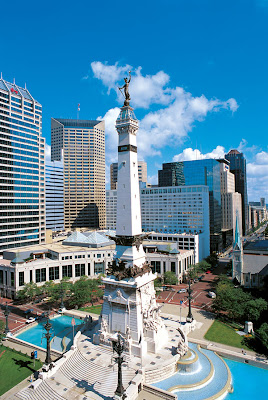 |
| Soldier & Sailor Monument |
A lot of people were surprised when “Indiana-no-place,” was selected to host 2012 Super Bowl XLVI. They were even more surprised when Indy hit it out of the ballpark, staging one of the best Super Bowls and greatest parties the world has known. More than a million people celebrated on the streets of Indy, while the Super Bowl was watched by 111 million others across the U.S. – the largest audience in television history.
Well, no one should have been surprised. The year before, Indiana swept the Great American Beer Festival, winning more prestigious beer medals than any other state. Good beer makes anything possible. But people who have never been to Indianapolis and assume it is just another dying, dull, rust and corn-belt Midwest city could not be more mistaken. Indy is amazing, and getting better by the day.
Indy’s very walkable downtown is green (with 350 acres of parks, rivers, tree-lined boulevards and canals); European (with impressive monuments and murals); trendy (with 300 restaurants and a national farm-to-table reputation); and artistic (with a unique pedestrian path that stretches across a state park, from a downtown zoo past world class history, art, and sports museums).
And did I mention beer? Locals Sun King and Upland lead a team of 64 Indiana breweries, and craft beer is supported by nearly every restaurant and bar in town. It is the cleanest city you will ever see, with horizon-to-horizon vistas of green trees, while armadas of white clouds float overhead in majestic Midwestern corn-blue skies.
 Best of all are the people. Eventually, Indy will be filled with hipster transplants and become the new Austin, Seattle, Portland or Denver, but right now Indy is home-base to a young, unpretentious crowd of locals who make no secret of the fact that they like good food (and lots of it), enjoy live music, partying, beer and fun. Today, bikers and joggers are few and far between, but an enlightened city leadership is building miles of new bike trails (including the most innovative urban bike path in the nation). With a new bike sharing program coming, Indy will soon lead the Midwest for their appreciation of the outdoors, health and recreation.
Best of all are the people. Eventually, Indy will be filled with hipster transplants and become the new Austin, Seattle, Portland or Denver, but right now Indy is home-base to a young, unpretentious crowd of locals who make no secret of the fact that they like good food (and lots of it), enjoy live music, partying, beer and fun. Today, bikers and joggers are few and far between, but an enlightened city leadership is building miles of new bike trails (including the most innovative urban bike path in the nation). With a new bike sharing program coming, Indy will soon lead the Midwest for their appreciation of the outdoors, health and recreation.
City Layout
 The downtown was designed in 1820 by Alexander Ralston, an assistant to Pierre L’Enfant, the19th Century “genius” who brought us endless traffic congestion and confusion in Washington D.C. Indy uses the same city plan, a center circle with spokes of streets that radiate out, criss-crossing with traditional north-south streets, making the downtown area hopelessly confusing to a first time visitor. But no worries. It’s small enough, there are ample maps and signage everywhere, and once you learn a few high landmarks that poke up into the sky along the horizon, you can get anywhere.
The downtown was designed in 1820 by Alexander Ralston, an assistant to Pierre L’Enfant, the19th Century “genius” who brought us endless traffic congestion and confusion in Washington D.C. Indy uses the same city plan, a center circle with spokes of streets that radiate out, criss-crossing with traditional north-south streets, making the downtown area hopelessly confusing to a first time visitor. But no worries. It’s small enough, there are ample maps and signage everywhere, and once you learn a few high landmarks that poke up into the sky along the horizon, you can get anywhere.
Indy is not Paris, and there are plenty of boring blocks for every great one. But it is a wonderful city to stretch your legs, and from any downtown hotel you can soon be strolling beside a canal, river, park or monument. Some things to do:
Bike The Indianapolis Cultural Trail
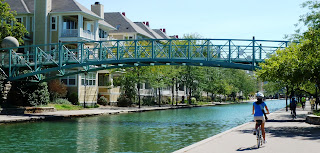 This brand new, $63 million, 8-mile, circular bike trail links every major downtown attraction and neighborhood and is a great way to see the city. Indy was planned in the 1800s with streets wide enough to turn a horse-drawn wagon. In the 20th Century, those wide streets were converted to one-way traffic, making it even easier to get out of town. The result was that everyone fled to live in the suburbs and downtown Indy was a ghost town after five. Today, enlightened city fathers have taken back one full lane of major downtown streets and turned them into bike paths. Creative signage and patterns on the path make the Cultural Bike Path easy to follow. Since the city is as flat as a cornfield, it’s easy to zip around by bike. A bike share program is coming soon, but until then, there are convenient bike rentals at the City Market, an old 1821 gem of a brick warehouse. With a huge open hall, iron railings along the second floor and lit by skylights, City Market is filled with stalls selling a variety of food and is a favorite lunch spot for locals. There’s an excellent tap room on the second floor with 20 local beers; ask for a free Indiana Beer Passport. It’s a guide to the state’s breweries and beers with room to add your own tasting notes.
This brand new, $63 million, 8-mile, circular bike trail links every major downtown attraction and neighborhood and is a great way to see the city. Indy was planned in the 1800s with streets wide enough to turn a horse-drawn wagon. In the 20th Century, those wide streets were converted to one-way traffic, making it even easier to get out of town. The result was that everyone fled to live in the suburbs and downtown Indy was a ghost town after five. Today, enlightened city fathers have taken back one full lane of major downtown streets and turned them into bike paths. Creative signage and patterns on the path make the Cultural Bike Path easy to follow. Since the city is as flat as a cornfield, it’s easy to zip around by bike. A bike share program is coming soon, but until then, there are convenient bike rentals at the City Market, an old 1821 gem of a brick warehouse. With a huge open hall, iron railings along the second floor and lit by skylights, City Market is filled with stalls selling a variety of food and is a favorite lunch spot for locals. There’s an excellent tap room on the second floor with 20 local beers; ask for a free Indiana Beer Passport. It’s a guide to the state’s breweries and beers with room to add your own tasting notes.
 |
| City Market |
See the Monuments
Young farm boys from Indiana have been cannon fodder for America since the Civil War, volunteering – and dying – in astonishing numbers. Indiana’s casualty rate in war is double the national average. Some 75% of the Indiana men eligible for the army volunteered to fight in the Civil War, the second highest per capita rate of any state in the country.
In tribute to these men, Indy has built more war monuments that any other city, and is second only to Washington DC in the total number of war memorials. Unlike many decaying city war memorials, the ones in Indy are huge, impressive, and kept in immaculate condition. The museums that go with them are a tad hokey and underfed, but the monuments are something else. Leading is the Soldiers and Sailors Monument, a 284-foot tower that is the heart of the city, from which all spokes lead out. You can climb 330 steps to the top or take a reasonably priced elevator for $2. Everything about the monument is colossal. This monument, nearly as high as the Statue of Liberty, honors soldiers of the Civil War and Spanish American War. You can walk around its huge statues of soldiers and civilians or sit by its fountains many times and see something new each visit. The Civil War museum in the basement could use some love, but buffs will enjoy it.
The Indiana War Memorial is a few blocks away and is a big, solid chunk of a memorial, with a basement military museum covering all wars from the Revolution on. Indy’s truly horrifying war museum is also here, honoring the USS Indianapolis, the WWII ship immortalized in Jaws. The ship was on a secret mission to deliver parts for the atomic bomb when it was sunk by a Japanese submarine. No one knew it had gone down and there was no attempt to rescue survivors. More than 900 men went into the water in the dark of night with nothing but lifejackets. Only 300 survived – many of those lost were eaten by swarms of sharks that surrounded the survivors and forced them into ever increasingly smaller circles. If you have trouble visualizing the horror of that, the museum has paintings to help.
Eat and Drink Indy Style
People in Indy like to eat…and why not? This area that has always appreciated farm-to-table, local restaurants having long traditions with local farms. Portions can be outrageous, particularly anything with pork (pork tenderloin sandwiches are the city’s signature dish). Some classics not to miss:
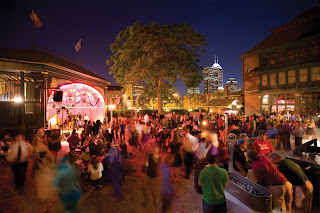 |
| Rathskeller |
The Rathskeller is a rambling, huge, authentic old German restaurant with a long beer hall lined with dead animal heads and an outdoor beer garden filled with live bands. Their wienershictizel is as good as any in Germany, and the portion was the size of a deflated basketball. Their pretzels are just as large and tasty. When there’s a band, the outdoor bar is filled with hundreds of young people.
St. Elmo Steak House is where all the celebrities who were in town for the Super Bowl had dinner. It’s a dark wood, clubby, men’s steak house, with a maze of different rooms and floors. They’re all cozy and Old World, particularly the main bar and the upstairs bar. St. Elmo is known for their spicy shrimp cocktail; if you can’t afford dinner, at least stop in for one of those.
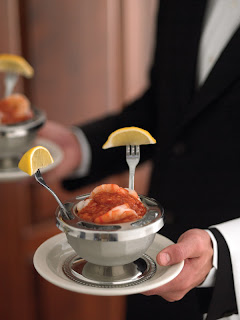 |
| St. Elmo’s shrimp cocktail |
Black Market is a gastro pub on the edge of downtown with a wonderful beer selection and a farm-to-table menu that changes regularly, depending on what’s fresh. If there is perch on the menu, get it. I’m not sure exactly what perch is (other than the most moist and delicious white fish I’ve ever eaten), but the room is hip and the beer list extensive, and you could transplant this restaurant to New York or San Francisco without missing a beat.
The Slippery Noodle Inn is Indiana’s oldest bar and a former hangout of gangster (and local hero) John Dillinger. Dillinger allegedly shot holes in the back bar. There are slugs in the bricks, and the bar staff will show them to you if you ask. Although Dillinger was gunned down by the FBI in Chicago, he’s buried in Indy at the Crown Hill Cemetery. The Slippery Noodle is a downtown institution with live blues bands and a good late night stop.
Walk White River State Park
In 1834, Indy built the Central Canal to the White River with the hope that it would provide power and transportation to turn the young city into an industrial giant. Fortunately, the canal silted up and was a complete failure. Indy never became a manufacturing center like Detroit or Pittsburgh.
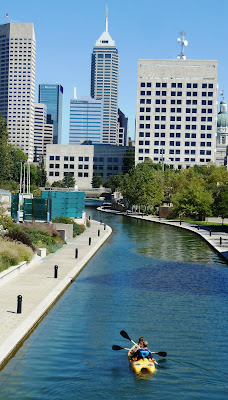 Today, the canal has gone through a renaissance and is lined with pedestrian and bike paths. It’s like the San Antonio Riverwalk, but without the bars and restaurants. That’s too bad – maybe the bars will come someday, but it’s still a very pleasant walk, and the canal is connected to a beautiful 250-acre park that runs to the river. Other trails wind along the White River with gorgeous skyline views in the background. In this natural area, you can walk from city’s fine zoo to a minor-league baseball stadium or to a series of impressive museums.
Today, the canal has gone through a renaissance and is lined with pedestrian and bike paths. It’s like the San Antonio Riverwalk, but without the bars and restaurants. That’s too bad – maybe the bars will come someday, but it’s still a very pleasant walk, and the canal is connected to a beautiful 250-acre park that runs to the river. Other trails wind along the White River with gorgeous skyline views in the background. In this natural area, you can walk from city’s fine zoo to a minor-league baseball stadium or to a series of impressive museums.
The zoo has a series of biomes that showcase everything from lions to dolphins. It’s right downtown, which makes it unusual. The Eiteljorg Museum is one of the nation’s finest museums of Native American and Western art. It’s gorgeous, with big paintings by big name Western artists like Albert Bierstadt and Frederic Remington. But while the paintings are big, the museum is just right — small and manageable.
Next, door, the Indiana State Museum is a hodgepodge of natural and cultural history, but the big news is the Star Wars exhibit is coming here from May to September 2013, filled with costumes, artifacts and original models from the movies.
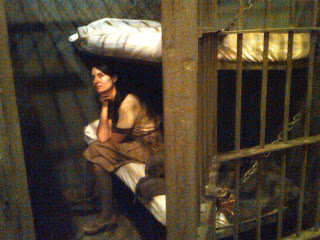 |
| Indiana Historical Society |
There’s a NCAA Hall of Champions (for those who have forgiven the NCAA for the shameful way they treated Penn State) but for a truly bizarre experience, walk along the canal to the Indiana Historical Society. The museum believes in the concept of living history and has hired actors to re-create scenes from the state’s past. For their Prohibition exhibit, you enter a jail cell, where an attractive woman actor tells you she has just been arrested for “soliciting.” Not that type of soliciting – she was trying to sell moonshine. If role-playing with an attractive woman in a jail cell is your type of thing, the museum is a bargain at $6.50. Hard to say what kids think of it, but you also encounter a policeman who takes your mug shot and a stern bible-pounding woman who will give you a hard time about drinking. All in all, it was fun and I will never forget that Indiana did away with prohibition long before the U.S. government did.
Visit a Museum
The Indianapolis Art Museum is a few miles from downtown, but worth the trip. It’s one of the top 10 in the nation in terms of its collection, and it’s located on 100 acres of land that was formerly the estate of pharmaceutical king J.K. Lilly Jr. That means there’s lots of money behind the museum, and it shows. There’s a bit of everything here, including an outdoor sculpture park, and lots of familiar paintings by big name artists.
Tour the Raceway
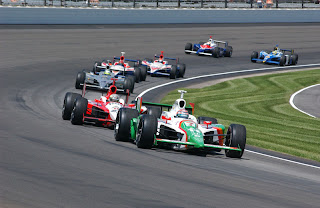 The Indy 500 is the biggest one-day sporting event in the world, drawing 400,000 people. It’s a good thing/bad thing for Indy. Certainly, if you like auto racing, this is the ultimate bucket list destination, and there’s plenty at the 2.5 mile track to see year-round including a racing hall of fame with many of the winning cars, expensive rides in race cars and pace cars around the track, and other tours and racing events. However, if you have little interest in auto racing, the Indy 500 tends to overshadow everything else about this up and coming city, which has far more to offer than a racetrack. It’s very easy to have an enjoyable weekend in Indy without ever going near anything to do with auto racing, except maybe having a beer or two with racing names.
The Indy 500 is the biggest one-day sporting event in the world, drawing 400,000 people. It’s a good thing/bad thing for Indy. Certainly, if you like auto racing, this is the ultimate bucket list destination, and there’s plenty at the 2.5 mile track to see year-round including a racing hall of fame with many of the winning cars, expensive rides in race cars and pace cars around the track, and other tours and racing events. However, if you have little interest in auto racing, the Indy 500 tends to overshadow everything else about this up and coming city, which has far more to offer than a racetrack. It’s very easy to have an enjoyable weekend in Indy without ever going near anything to do with auto racing, except maybe having a beer or two with racing names.
IF YOU GO: Most people will see Indy on a convention or sporting event. They have an excellent set up with great hotels, restaurants and attractions all within walking distance. It would also make a good add-on to a Kentucky Bourbon Trail trip. Indy is two hours from Louisville and three hours from Lexington, so it makes a nice loop. For info: . visitindy.com









December 22, 2012 @ 10:52 pm
Wow, I had no idea Indianapolis had so much to offer — and so many great beers!
October 15, 2013 @ 8:09 am
Actually, Indianapolis was a vehicle manufacturing center before Detroit was one. The canal didn't work out but the trains were a whopping success, so Indianapolis has always been strong in manufacturing.
March 1, 2014 @ 9:24 pm
Nice article. I think it is useful and unique article. I love this kind of article and this kind of blog. I have enjoyed it very much. Thanks for your website.
carbon wheel rental
August 31, 2015 @ 6:40 am
Great article. Very proud of the improvements I have seen in our city, especially in the last few years.